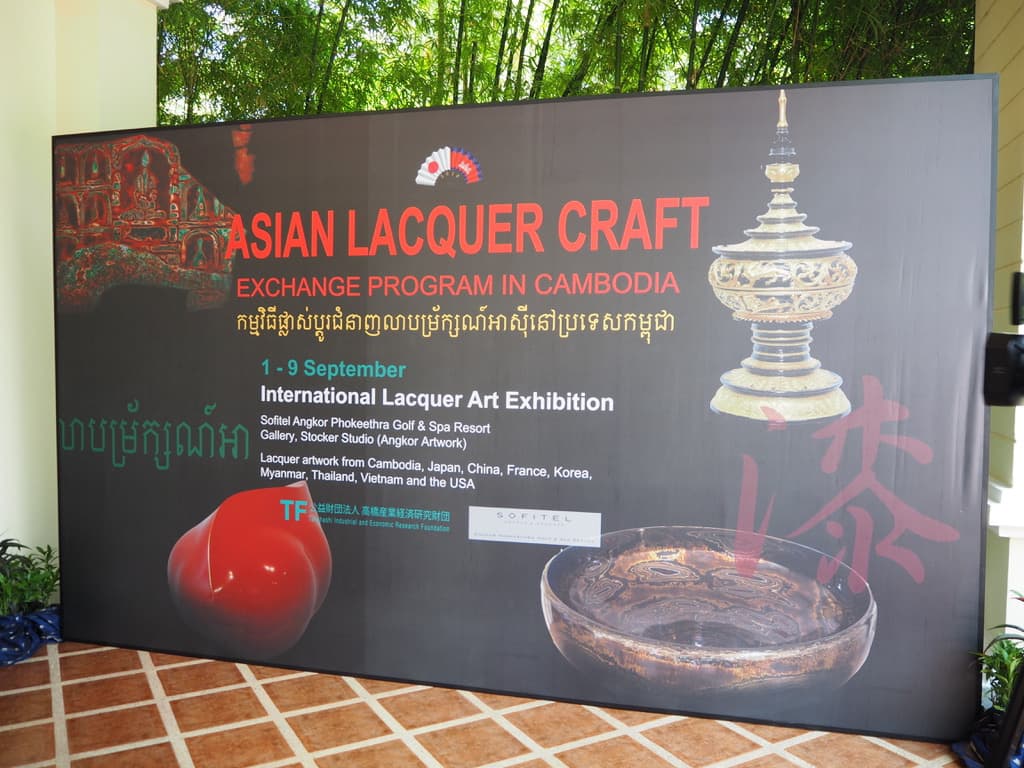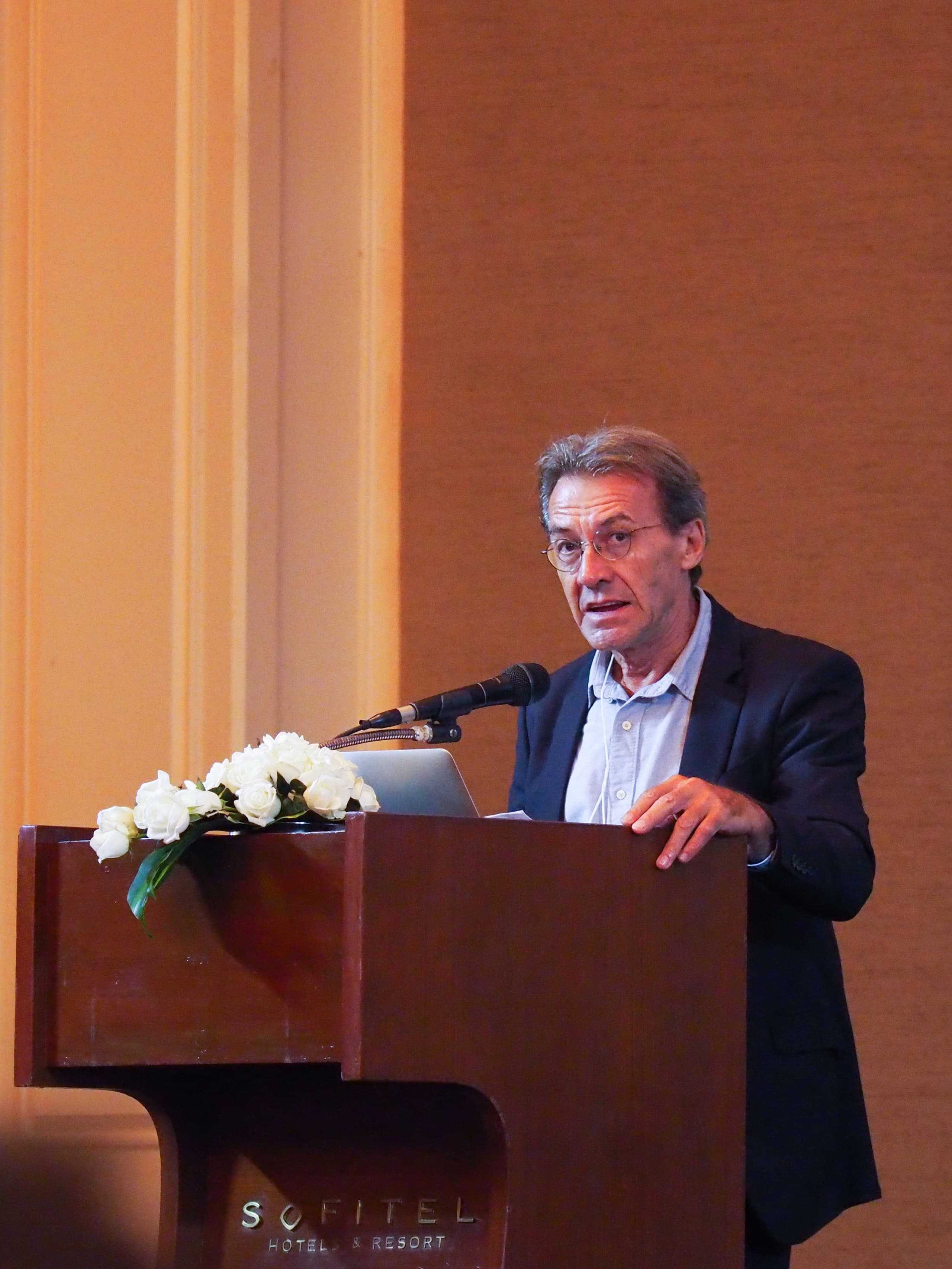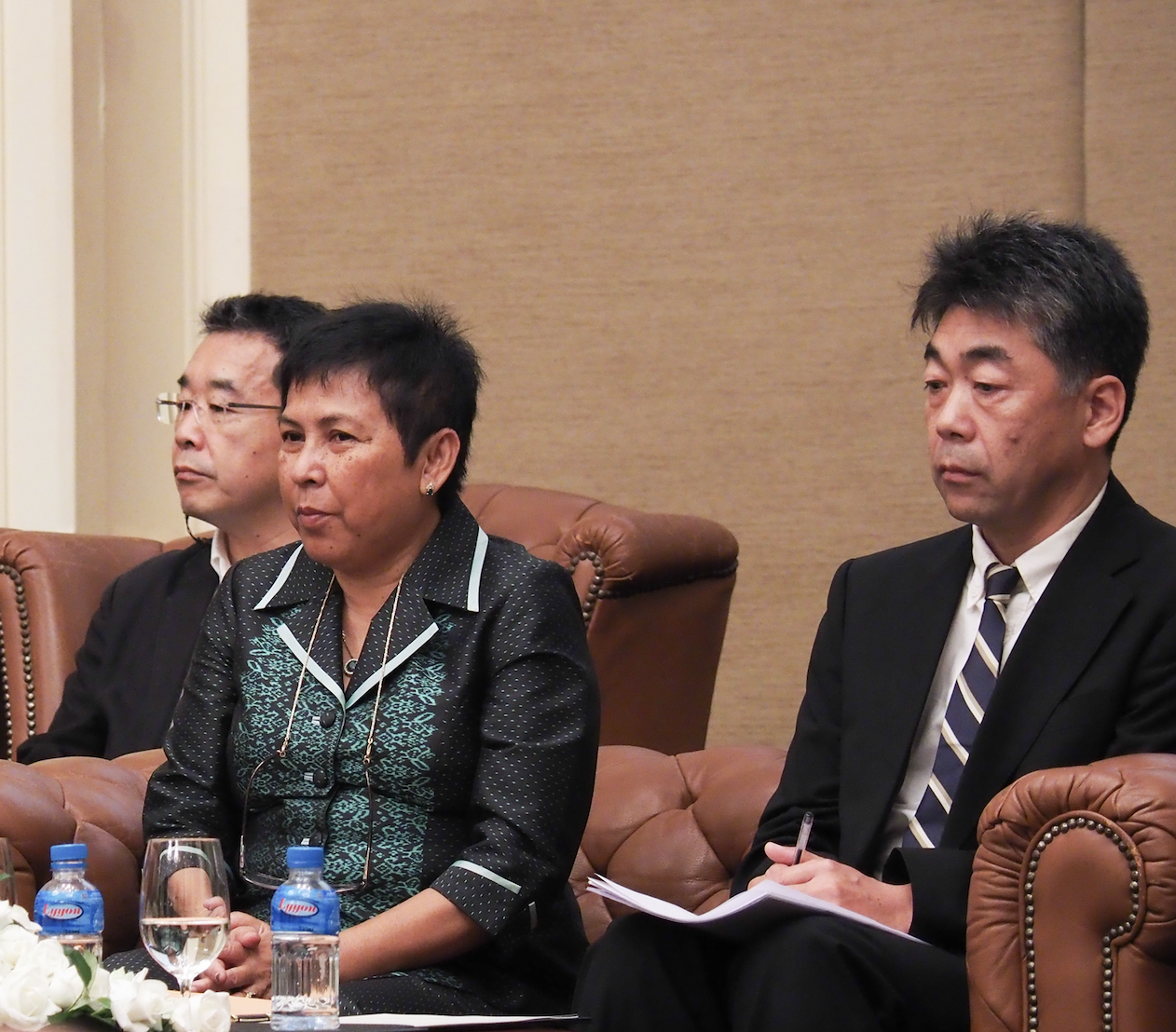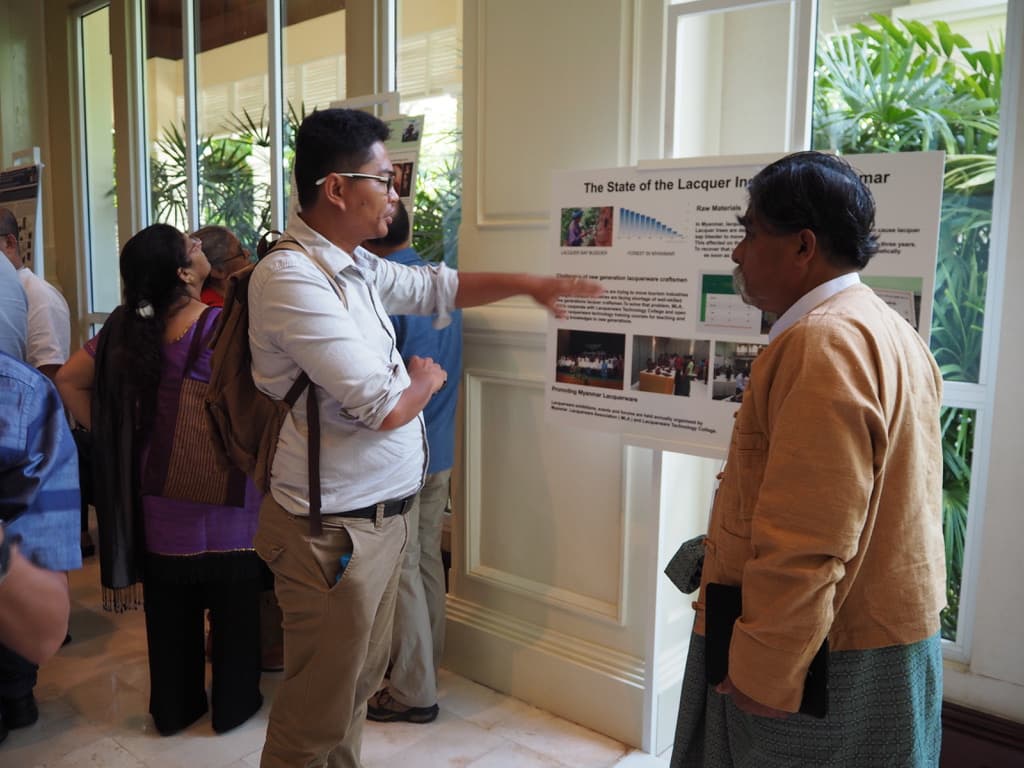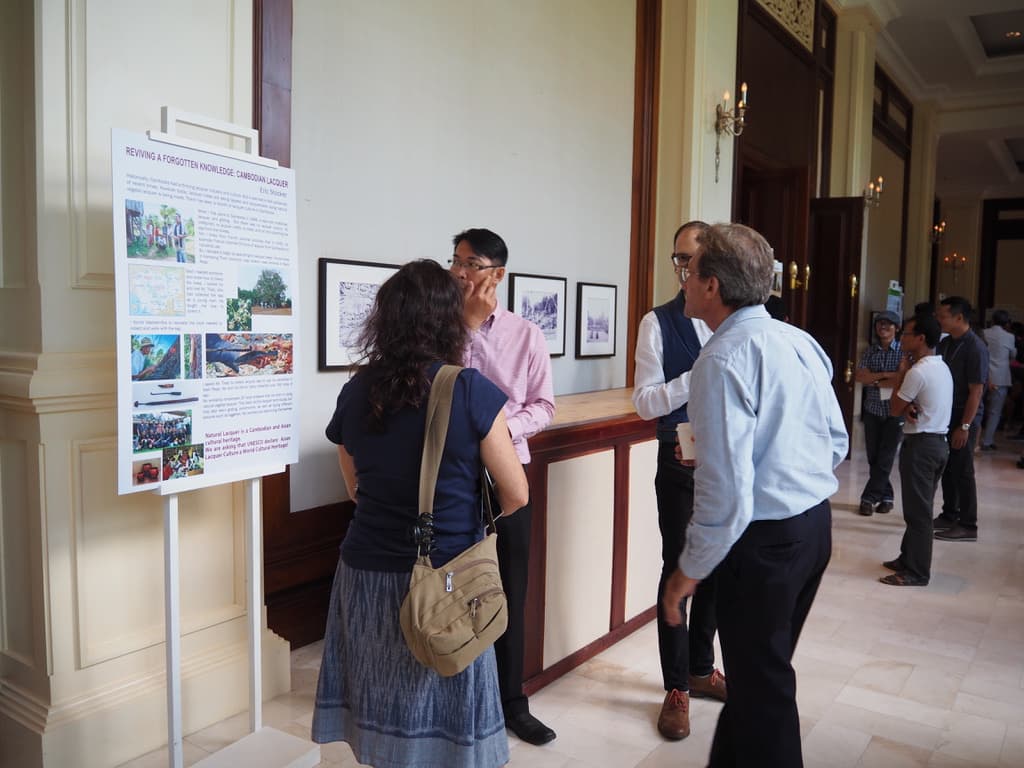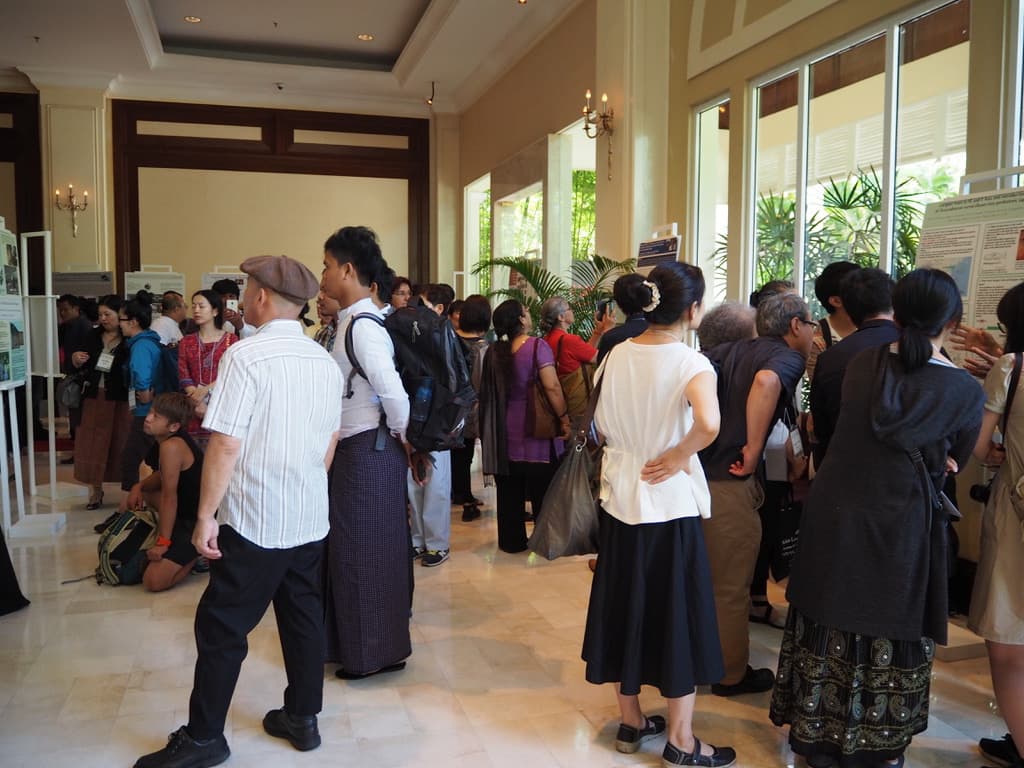Asian Lacquer Craft Exchange Program, in Cambodia, 2018
Opening Ceremony
1 September (9:30~12:00) Ballroom, Sofitel Angkor Phokeethra Golf & Spa Resort
Overview of the Asian Lacquer Craft Exchange Research Project
Sakurako Matsushima, Director, Asian Lacquer Craft Exchange Research Project
Director Matsushima welcomed everyone to the Program and gave a short overview of the Project’s history
Opening Remarks:
Mr. Naoki Mitori from the Consulate of Japan in Siem Reap
Eric Stocker, Stocker Studio, Angkor Artwork
Opening Statement:
Her Excellency Phoeurng Sackona, Minister of Culture and Fine Arts
Her Excellency Dr. Sackona remarked how exciting it was to have so many artists and lacquer experts from around Asia and the world present in Siem Reap for the exhibition and symposium. She wished the program very success and officially declared the Program opened.
Lectures, Poster Session and Panel Discussion
Lectures
1 September (10:10~11:10) Ballroom, Sofitel Angkor Phokeethra Golf & Spa Resort
“Natural Lacquer Resurgence in Cambodian”, Eric Stocker, Stocker Studio (Angkor Artwork).
Historically, Cambodia had a thriving lacquer industry and culture. But this was lost in the upheavals of recent times. However today, lacquer trees are being tapped and lacquerware using natural vegetal lacquer is being made. Angkor Artwork is unique in Cambodia because it the only workshop where natural Cambodian lacquer used. The chain of events that led to the revival of lacquer industry and culture in Cambodia was discussed.
“The Chemistry of Cambodian and Asian Urushi”, Dr. Hiroshi Oyabu, researcher at the Kyoto Municipal Institute of Industrial Technology and Culture
This lecture was overview of the science and the technology of Cambodian and Asian Urushi. Urushi is the Japanese word for Asian Natural Lacquer. In particular, this talk explained the differences in the main components and the composition of Urushi from various Asian countries, the urushi refining process in Japan, and the positive and negative characteristics of Urushi as a coating material. Finally, Dr. Oyabu discussed the research on Cambodian lacquer done by Eric Stocker at the Institute in Kyoto.
Poster Session
1 September (14:00~14:50) Ballroom, Sofitel Angkor Phokeethra Golf & Spa Resort
The poster session focused on current state of Asian lacquer. Topics included lacquer art and techniques, lacquer tree cultivation, the scientific study of lacquer, conservation and restoration, and natural lacquer advocacy and promotion.
-The Current State of Lacquer in Cambodia, Eric Stocker, Stocker Studio (Angkor artwork), Cambodia
-Conservation - Restoration - Restitution, Catherine Nicholas, France
The Collaborative Project of Conservation of Nanban Table from the Collection of Museum of King Jan III’s Palace, at Wilanów, Warsaw, Poland - Joanna Koryciarz-Kitamikado, Poland
-Current State of Contemporary Lacquer in Thailand- Sumanatsya Voharn, Lecturer in Design, Chiang Mai University, Thailand
-Chinese lacquer painting education - Jin Hui, Professor, Shanghai Academy of Fine Arts, China
-History and Contemporary – Chinese lacquer art - Jin Hui, Professor, Shanghai Academy of Fine Arts, China
-Vietnamese Lacquer Art, a Symbol of Cultural BlendingTuan Trinh, Vietnamese Song Mai lacquer artist, Vietnam-The State of Lacquer Arts and Crafts Education in Myanmar, Daw Nilar Myint, Principal, Lacquerware Technology College, Bagan, Myanmar
-The State of Lacquer Industry in Myanmar, U Maung Maung, Chairman, Myanmar Lacquerware Association, Myanmar
-Urushi Sap Collection in Japan –The efforts of Ichikiro no kai (an NGO) to maintain domestic urushi production, Miha Isoi, Kagari Miyoshi
-Continuing Traditions – Kijian Daigo Urushi Yamizonuri,Tsuji Thoru
-Earliest evidence of the Lacquer tree (Toxicodendron vernicifluum) and the Lacquer culture of the Jomon period in prehistoric Japan
Yuichiro Kudo (National Museum of Japanese History), Shuichi Noshiro (Meiji University) and Yuka Sasaki (Meiji University), Japan
-Lacquer trees in SE and E Asia and introduction of Toxicodenron vernicifluum- into prehistoric Japan, Shuichi Noshiro (Meiji University), Yuichiro Kudo (National Museum of Japanese History),Yuka Sasaki (Meiji University, Paleo Labo Co., Ltd.), Japan
-Use of Lacquer trees (Toxicodendron vernicifluum-) for lacquer collection and lowland construction during the Jomon Period in prehistoric Japan, Yuka Sasaki (Meiji University, Paleo Labo Co., Ltd.), Shuichi Noshiro (Meiji University) and Yuichiro Kudo (National Museum of Japanese History), Japan
-Characterization of Cambodian lacquer sap and scientific analysis of historical Cambodian lacquerware
Tetsuo Miyakoshi*, Natsumi Akamae, Takayuki Honda, Department of Applied Chemistry, School of Science and Technology, Meiji University, Japan
-The Brilliant Shells and its role in Korean Mother of Pearl Inlay Lacquerware Technique, Kim Ha-won, Occhil artist, Korea
-Urushi-Art (Japanese Lacquer), Aoki Kodo, Associate Professor, Tokyo University of the Arts, Japan
-Natural Lacquer: An Intangible - Making Lacquer Arts and Culture a World Cultural Heritage, Ken Dillon, Asian Lacquer Craft Exchange Research Project, Japan
Panel Discussion
1 September (14:50~15:50) Ballroom, Sofitel Angkor Phokeethra Golf & Spa Resort
Title: Promoting and Preserving Lacquer Arts & Culture - Natural Lacquer Advocacy
Moderator: Ken Dillon
Panelists
- U Maung Maung (Chairman, Myanmar Lacquerware Association)
- Jin Hui (Professor, Shanghai University)
- Sumanatsya Voharn (Lecturer, Chiang Mai University, Thailand)
- Eric Stocker (Owner, Angkor Artwork, Siem Reap, Cambodia)
- Trinh Tuan (Lacquer Painter, Hanoi, Vietnam)
- Itani Yoshie (Ph.D, Historian, Japanese Art History; Professor, Tokyo University of the Arts, Japan)
Education
In the public mind “lacquer” means any paint or varnish. Few people, even in China, Japan, and SE Asia, know what “natural lacquer” is. Most have only vague knowledge of its long history and importance in their cultures.
How to best educate the public, especially the young, about natural lacquer arts, crafts and culture?Sumanatsya Voharn discussed the need to introduce lacquer studies in Thai art education curriculums. She also discussed her Kintsugi project in which lacquer techniques are used to repair pottery as a simple and interesting way to introduce the public in lacquer arts. Jin Hiu gave an overview of how China is supporting traditional crafts education. U Maung Maung pointed to the importance in Myanmar of having the Lacquer Technology College and Myanmar Lacquer Association to strengthen the lacquer community. Trinh Tuan described the program at his university and the art programs he organizes for children. He also discussed the need for local exchange programs, modeled on Asian Lacquer Exchange Project in each nation.
Promotion
Natural lacquer arts & crafts are ancient with deep roots in Asian societies. Lacquer arts is a uniquely Asian aesthetic. Lacquer is an inheritance, a gift that Asian cultures have shared with the World. Natural Lacquer’s importance as an Asian Cultural Heritage deserves more and better recognition.
How to best to preserve & strengthen urushi culture in Asia?
Several panelists pointed to the importance of Asian Lacquer Craft Exchange Research Project in bringing the lacquer communities of Asia and the world together and spoke of the need to continue the Project. Trinh Tuan reiterated the need for more locally organized exchange programs to increase awareness of the variety of lacquer arts and crafts across cultures. Eric Stocker talked of the need for more direct exchanges between artists and artisans in SE Asia to strengthen each other’s skills, technique and design. U Maung Maung said that national organizations like the Myanmar Lacquer Association could serve to unite artisans and lacquer studios to give them a common platform and voice.
Proposal
Ken Dillon proposed having Natural Lacquer arts, crafts and industry declared an Asian Cultural Heritage. He stated that the nations of Asia should recognize Natural Lacquer as a shared cultural heritage and suggested working toward this goal for the 2020 Program in Tokyo. He asked the panel and audience how to begin. And what steps to take?
U Maung Maung strongly supported the idea, saying that it would draw attention to and increase public awareness of the uniqueness of lacquer crafts and culture. Dr. Itani also thought the proposal a good idea. She, however emphasized the complexity of the process, and need to form committees in each nation, to gather support from other art organizations, institutions, and government agencies. The discussion went on for some time, centering on how best to begin. The conclusions can best be summarized as organizing committees or interest groups in each nation, educating institutions and the public to the fact that lacquer arts is a shared Asian Heritage, and to continue communicating with each other.
